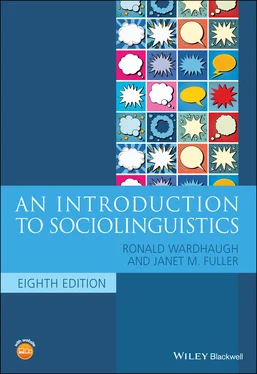But we would like to encourage readers to approach the study of sociolinguistics not only as an empirical approach to studying language and society, but as a way of viewing the world around you. In sociolinguistics, we seek to analyze data so that we can make generalizations about language in society, but also to question both our findings and the very process of doing research. Take, for instance, the topic of nicknames. There is a stereotype that men use nicknames and women do not, exemplified in the following joke:
If Diana, Natalie, Naomi, and Maria meet for lunch, they will call each other Diana, Natalie, Naomi, and Maria. But if Matt, Peter, Kirk, and Scott go out for a brewsky, they will call each other Dutch, Dude, Doofus, and Pencil.
We could investigate this sociolinguistic phenomenon by surveying people about their nicknames and also observing or recording interactions in which they are addressed by close friends and family members. We might find, indeed, that the men in our study are often called nicknames, while the women rarely are. But we would like to go deeper than this generalization; why do we ask this question in the first place? Why do we assume that the categories of ‘men’ and ‘women’ are socially relevant? What is it about nicknames that makes using them, or not using them, significant social behavior? And even if most men are called by a nickname and most women are not, how do we explain the existence of individual men who do not have nicknames, and the individual women who do?
Thus, while in sociolinguistics we analyze linguistic interactions with the goal of making generalizations, we also question these generalizations and examine how they, in turn, influence how we use language. In short, the goal of sociolinguistics is not to make simple observations (e.g., men call each other nicknames, women do not) but to study the complex ways in which societal norms are intertwined with our language use (e.g., what it means to be a male or female member of a particular society may influence the terms we use to address each other).
We will come back to these points repeatedly: language, society, and sociolinguistic research findings must all be viewed in their social contexts, interpreted, and redefined. To begin, however, we will offer a starting point for discussing language in society. By society, we mean a group of people who are drawn together for a certain purpose or purposes; this is a rather vague and broad term, and throughout this book we will be engaged in discussing how to draw meaningful boundaries around a group of language users for the purposes of studying their language (see in particular chapter 3). We use the term language to mean a system of linguistic communication; this includes spoken, written, and signed modes of communication. A note here about terminology: although the majority of the research we will refer to is on spoken language, there is an increasing number of studies looking at written discourse (especially from social media) and we also do not wish to exclude those who communicate through signed languages. Thus, we will use the term ‘language user’ instead of the more commonly used term ‘speaker’ as a general term.
The main idea we would like to convey here is that language is inherently social. A society must have a language or languages in which to carry out its purposes, and we label groups of people with reference to how they communicate – e.g., Spanish speakers , bilinguals , American Sign Language users . This connection is inevitable and complex; our purpose here is to study the relationship between language and society in more specific ways which help us more clearly define and understand both the social groups and the ways they speak.
In this introductory chapter, we will present some of the basic concepts in the field of sociolinguistics: what defines a language, what it means to ‘know’ a language, the nature of differences across and within languages, the importance of social group membership in language use, and different ideas about the relationship between the worldviews of these groups and the languages they use. Further, we will provide a brief discussion of how sociolinguistics draws on ideas from a variety of disciplines for key concepts and approaches to the study of language.
A mainstay of introduction to linguistics textbooks (see for example Yule 2017) is a discussion of the nature of language and, often, how it differs from animal communication. Although the human ability to learn language is innate, a person learns a language through contact with others and thus language is culturally transmitted– an idea which is at the heart of sociolinguistics. Other features include discreteness, productivity, and displacement, which can be used to distinguish between non‐linguistic means of communication such as gestures and language. Another important feature is that the relationship between the form and meaning of a linguistic sign is arbitrary; aside from a few onomatopoetic words, such as words for animal sounds (e.g., meow , moo ), the form (including both the sound and the way it might be written) of a morpheme is not derived from its meaning, or vice versa. We see evidence for the arbitrariness of the form–meaning relationship in the presence of synonyms within languages (e.g., sofa , couch ) as well as the fact that words from different languages may have drastically different forms but still have the same meaning (e.g., English love , Swahili kupenda ).
By examining how language works in its social context, sociolinguistics has greatly advanced our understanding of the relationship between signs and their meanings. The philosopher Peirce (Hartshorne et al.1931) suggested a three‐way typology of signs. A symbolis a sign which has developed a conventional meaning; for example, a heart shape indicates love. There is nothing about this shape which inherently leads to this interpretation; it is simply a correspondence which has grown out of use. As noted above, linguistic signs are generally symbols, that is, we understand them because of conventionalized meanings, not because of any ‘natural’ connection between the sign and its meaning. An iconis a sign which in some way resembles the object it refers to, such as a map. Although linguistic signs are not generally held to be iconic, particular varieties may be seen as having an iconic relationship with the people who use them (see chapter 3for a discussion of this in the section on language ideologies). An indexis something which ‘points to’ something – such as literal pointing with your finger to indicate what you are referring to, or the commonly used example of smoke indexing fire. Smoke does not resemble fire, but since the two often co‐occur, we associate them with each other (as shown in the idiom ‘when there’s smoke there’s fire’). The concept of indexicality is one which has drawn great interest in sociolinguistics. Put simply, certain varieties often come to index certain types of language users; thus indexicality is inherently a central aspect of the study of language in society. We will expand on the use of this concept in sociolinguistics in the next chapter.
As mentioned in the last section, language is culturally transmitted, and while the ability to learn a language is innate, we are not born knowing a particular language, nor are we genetically pre‐dispositioned to speak a certain variety, but we learn the language(s) we are exposed to. The system (or the grammar, to use a well‐known technical term) is something that each language user ‘knows,’ but two very important issues for linguists are (1) just what that knowledge comprises and (2) how we may best characterize it.
Читать дальше




![Andrew Radford - Linguistics An Introduction [Second Edition]](/books/397851/andrew-radford-linguistics-an-introduction-second-thumb.webp)







